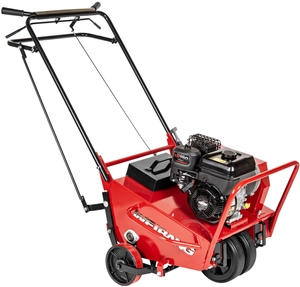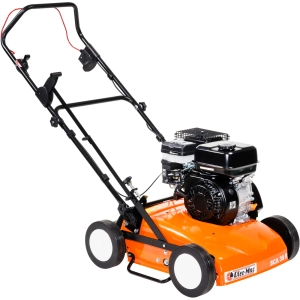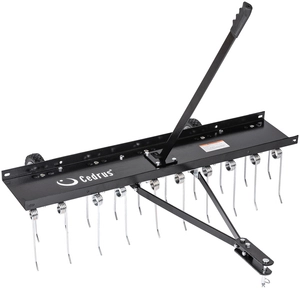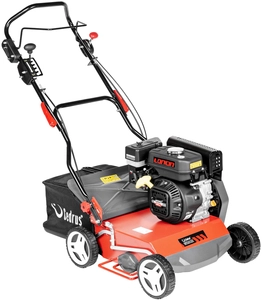What is scarification? Which scarifier to choose?

Fresh air for your lawn
In addition to regular mulching, lawns should always be scarified in spring and autumn to again get enough "air to breathe." The scarifier's steel blades penetrate the turf and thoroughly remove dry grass, moss and other plant debris. After scarifying, these areas should be immediately re-watered, re-seeded and heavily watered. These agents improve both nutrient absorption and hydration, and ultimately promote grass growth. AL-KO electric and petrol scarifiers help effectively in this metamorphosis.
Always the right working depth
The working depth can be set to one of five levels with a single movement, which is important because, for example, the blades should not be recessed too much when scarifying so that they do not wear out unnecessarily quickly and damage the roots of the lawn.
Engine cooling
Large ventilation slots ensure adequate engine ventilation and are attractively integrated into the housing of our scarifiers.
Once, twice and folded
With two quick folding handles, the scarifier can be folded up in a snap. This ensures easy transportation and saves space during storage.
Accessory replacement
The work shaft can be quickly and easily replaced without tools. A visual safety indicator shows whether the roller has been inserted correctly.
Combustion, electric or battery-powered?
Medium-sized lawns can be cleaned quickly and easily with an electrically powered, emission-free, low-noise device. Ideally suited for this is the HECHT 1848
The advantage of petrol scarifiers is that it can be used flexibly and without cables, making it ideal for a larger garden or hard-to-reach areas. Its powerful motor is also suitable for harder grassy surfaces.
How to scarify?
Is it time to scarify?
Run a metal rake over the lawn: if you see moss or old mowing residue, it's time to scarify - even if weeds proliferate on the lawn, this is a clear sign that the grass is not growing properly.
How the scarifier works
Our scarifiers have a rotating shaft with steel blades that briefly penetrate the ground with each rotation.
Height adjustment
When scarifying, set the right height, do not exceed the penetration depth of two to five millimeters. Remove scarification residue as soon as possible - the attached garbage can will help with this.
Soil condition
On clay soils, shaded lawns or wet areas, a so-called "lawn thatch" usually forms. Such lawns should be scarified and aerated more often.
The right time to scarify
It is best to carry out scarifying in spring (April) and autumn (September). After scarification, the lawn should be given time to recover. Please cut your lawn in advance.
Diesel or electric scarifiers?
Electric scarifiers are suitable for medium-sized lawns, have low noise levels and are emission-free. Petrol scarifiers can be used on large areas without being connected to a power source.
Scarifying and aerating
Almost every garden owner dreams of a beautiful and lush lawn. But why do some gardens look like a dry desert, while the lawn in the neighboring garden shines anew every year with the most beautiful greenery? First of all, because the neighbor regularly scarifies and aerates the lawn. Two processes that are essential for a healthy lawn. Aeration is necessary so that the lawn can absorb enough nutrients and get enough air to breathe. Simply put, scarifying is more intensive aeration, which also cuts the turf. This further loosens the soil and allows it to regenerate wonderfully. Gardeners usually scarify the lawn in spring to refresh it after the cold season. This should be repeated in the autumn. Especially if the winter was particularly hard beforehand. This gives the lawn the nutrients it needs to survive the next winter.
What exactly does scarification mean?
The scarifier has a scarifying roller with stepped steel blades. They penetrate the turf and remove thatch, moss and plant debris. This can be compared to a sturdy narrow-toothed rake that digs a little into the ground and takes some of the desired lawn with it as it pulls out. This method can also be used on small areas; for large thatch areas, a scarifier with a combustion engine is recommended. Regardless of the type of device used, it is important to remove parts of plants that died in the winter, as they take away light and air from the sprouting grass. Note that only dry, freshly mowed lawn should be scarified.
When and how often the lawn should be scarified?
Lawn should not be scarified too early - only when frost can be ruled out. It is also important that the ground is dry. To get a good scarifying effect, the grass should first be cut to a length of about. 3 to 4 cm. This makes it easier for the aerating roller to get through the turf. Treatment should be done in March or April depending on the weather. This is also possible in September, as long as it is warm enough. Simply scarify once or twice a year.
Another tip: harvested thatch should not be later placed on compost.
Keep this in mind when ventilating
In addition to scarifying, the lawn should be regularly ventilated. Some of our equipment is already equipped with an aeration roller in addition to the scarifying roller. As opposed to scarification, aeration is possible to perform all year round, so that the greenery stays fresh longer. Technically, this process is called "aeration".
The turf is lightly scratched with an aeration roller equipped with spring steel tines. The process is important because the surface gradually thickens, and thus no longer receives oxygen. In addition, the lawn absorbs water better after aeration and prevents the so-called "water soak. This allows nutrients to better reach the roots of the grass.
Measures after aeration and scarification
In both cases, the grass should then be heavily watered and fertilized. It's a boon for the soil and plants, which receive water all the way to their roots in addition to oxygen. When the fertilizer is scarified, it has the greatest effect, as nutrients can then be best absorbed and processed. Alternatively, sow new lawn seed.
The right scarifying equipment
When buying a device, pay special attention to the working width and dual functionality (scarifying and aerating). Nowadays, scarifying is sometimes done with a handheld device, such as a rake or hand scarifier. This work is tedious, labor-intensive and difficult to do with a larger lawn. The electrically powered version makes our work much easier and reduces the effort. High-quality scarifying equipment also collects felt and dead plant debris into a collection basket, so there is no need to scrape it away. Like lawn mowers, scarifiers are also available as gasoline- or electric-powered devices.
While gasoline engines tend to have more powerful motors and are optimally designed for larger lawns, electric scarifiers are particularly useful because of their lighter weight. The biggest drawback here is the power cable, which you have to carry with you during the entire work process.
Recommended

IKRA IEVL 1532 2-in-1 AREATOR THREAD TREATER + 2 ROLLERS 1500W PREMIUM POWER EWIMAX - OFFICIAL DISTRIBUTOR - AUTHORIZED IKRA DEALER

WEIBANG WB457AB SPRINKLING TURBLE 5 HP B&S Briggs & Stratton 750 Series WB457 / WB 457 lawn aerator EWIMAX - OFFICIAL DISTRIBUTOR - AUTHORIZED WEIBANG DEALER

WEIBANG WB517AB SPRINKLING RUBBLE 5 hp B&S Briggs & Stratton 750Series WB517 lawn aerator EWIMAX - OFFICIAL DISTRIBUTOR - AUTHORIZED WEIBANG DEALER

OLEO MAC OM LINE SRH 40 L65 PETROL AERATOR LAWN SCARIFIER 6 KM METAL HOUSING PREMIUM OFFICIAL DISTRIBUTOR - AUTHORIZED OLEO MAC DEALER

DAEWOO DSC 4000 SPRELINER COMPACTIONAL THREAD TILLER AREATOR 2in1 + 2 ROLLERS METAL CABINET - OFFICIAL DISTRIBUTOR - AUTHORIZED DAEWOO DEALER

WEIBANG WB384RB PROFI PROFESSIONAL STEADY COMPACT VERTICULATOR Briggs&Stratton WB384 WB 384 EWIMAX - OFFICIAL DISTRIBUTOR - AUTHORIZED WEIBANG DEALER

CEDRUS WR01 SPRELINER TREATER AREATOR 2-in-1 5.5 HP - EWIMAX - OFFICIAL DISTRIBUTOR - AUTHORIZED DEALER CEDRUS

WEIBANG WB486CRB PROFI PROFESSIONAL COMPACTIONAL GRANDFULATOR Briggs&Stratton WB486 / WB 486 - EWIMAX - OFFICIAL DISTRIBUTOR - AUTHORIZED WEIBANG DEALER

CEDRUS SP31129 GARDEN ROLLER WITH WHEELS AERATOR FOR TRAVELLER 91cm - OFFICIAL DISTRIBUTOR - AUTHORIZED DEALER CEDRUS

DAEWOO DSC 1500E GREEN AREATOR 2-in-1 AERATOR + 2 ROLLERS 1300W WIDTH 32 cm - OFFICIAL DISTRIBUTOR - AUTHORIZED DAEWOO DEALER

OLEO MAC SCA 38 R DIESEL LAWN SCARIFIER PREMIUM METAL HOUSING 1800792 OFFICIAL DISTRIBUTOR - AUTHORIZED OLEO MAC DEALER

OLEO MAC OM-LINE WE40L 5.5 HP / 40cm PREMIUM METAL CABINET OO-OTHWE40L OFFICIAL DISTRIBUTOR - AUTHORIZED DEALER OLEO MAC

CEDRUS SP31519 AERATOR AREATOR GARDEN FERTILIZER SEED PLACER 2in1 - Poj. 80 L / 103 cm

CEDRUS SP31509 AERATOR AREATOR GARDEN FERTILIZER SEED PLACER 2in1 - Poj. 43.5 L / 81 cm

CEDRUS SP31102 GARDEN TRAKTOR PIPE AERATOR 122 cm - OFFICIAL DISTRIBUTOR - AUTHORIZED DEALER CEDRUS

CEDRUS SP31101 RAKE BRACKET FOR GRABIE AERATOR 100 cm - EWIMAX - OFFICIAL DISTRIBUTOR - AUTHORIZED DEALER CEDRUS


